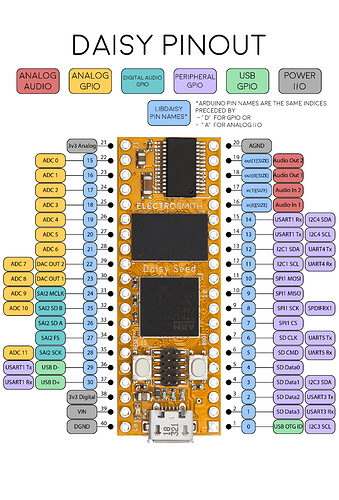Hey there, fairly new to Daisy (and C++) but loving it so far!
Just wondering if there are any guides/examples out there for some of the libDaisy APIs, more specifically AnalogControl? Managed to get Led and Switch working by trial and error, controlling brightness of an LED with a potentiometer but would like to eventually be able to use the AnalogControl class.
Also following along with the examples I was unable to use pin names like D5, A0 etc and had to use hw.GetPin(), is there something I’m missing there?
Thanks in advance for any knowledge you may be able to share!
#include "daisy_seed.h"
#include "daisysp.h"
using namespace daisy;
using namespace daisysp;
DaisySeed hw;
Switch b[4];
Led l[4];
bool bState[4];
float val[4];
void AudioCallback(AudioHandle::InputBuffer in,
AudioHandle::OutputBuffer out,
size_t size)
{
for(size_t i = 0; i < size; i++)
{
out[0][i] = in[0][i];
out[1][i] = in[1][i];
}
}
void update()
{
for(int i = 0; i < 4; i++)
{
b[i].Debounce();
bState[i] = b[i].Pressed();
l[i].Set(val[i]);
l[i].Update();
val[i] = hw.adc.GetFloat(i);
}
}
int main(void)
{
hw.Configure();
hw.Init();
hw.StartLog();
hw.SetAudioBlockSize(4); // number of samples handled per callback
hw.SetAudioSampleRate(SaiHandle::Config::SampleRate::SAI_48KHZ);
hw.StartAudio(AudioCallback);
AdcChannelConfig adc_config[4];
int x = 18;
for(int i = 0; i < 4; i++)
{
b[i].Init(hw.GetPin(i));
l[i].Init(hw.GetPin(i + 4), 0, 1000.0);
adc_config[i].InitSingle(hw.GetPin(x));
x--;
}
hw.adc.Init(adc_config, 4);
hw.adc.Start();
while(1)
{
update();
}
}
